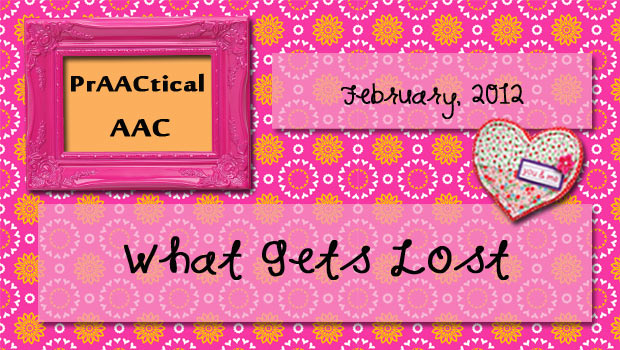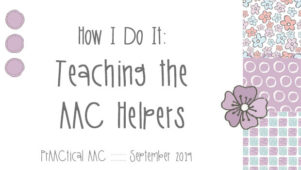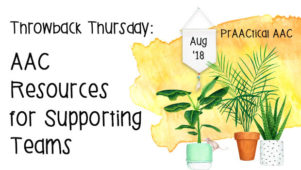What Gets Lost

 Imagine having one key communication strategy and no one knew that it existed. This horrifying experience was documented in the book ‘I Raise My Eyes to Say Yes,’ the autobiography of Ruth Sienkiewicz-Mercer. For years, she effectively used eye gaze with her family to answer yes/no questions, but when Ruth was placed at a residential facility, things eventually changed. Staff turnover, something we’re all familiar with, was the culprit. With time, new staff came in and didn’t realize that Ruth communicated with her eyes. Ruth was silenced for years until someone noticed that her ‘eyes up’ movement wasn’t reflexive or random.
Imagine having one key communication strategy and no one knew that it existed. This horrifying experience was documented in the book ‘I Raise My Eyes to Say Yes,’ the autobiography of Ruth Sienkiewicz-Mercer. For years, she effectively used eye gaze with her family to answer yes/no questions, but when Ruth was placed at a residential facility, things eventually changed. Staff turnover, something we’re all familiar with, was the culprit. With time, new staff came in and didn’t realize that Ruth communicated with her eyes. Ruth was silenced for years until someone noticed that her ‘eyes up’ movement wasn’t reflexive or random.
We must do a better job of documenting AAC systems in a way that makes it easier for new communication partners to understand how our clients communicate. In actuality, it’s relatively easy to explain about signing and yes/no signals. Those are the more conventional means of expression among the unconventional ways of communicating. But what about other modalities? We’ve been talking about multimodal communicationthis month. How do we share information about the gestures and behaviors that our AAC friends use so well to communicate? What can we do to let people know what his/her communication board/book is actually like? How can we efficiently convey what vocabulary the communicator has to a fellow clinician or teacher?—It’s a bit ironic that the field of AAC, so grounded in representing information visually, still uses written reports as the gold standard for sharing information on a person’s AAC system. Clinical reports, SOAP notes (ugh!), IEP forms, Present Level of Performance summaries, and the like are our primary means of documenting how our friends who use AAC communicate. I don’t know about you, but from where I sit, these methods of conveying information about AAC systems leave a lot to be desired. Not only to people not read and process these things as well as they should (let’s be honest about that), but they are just not effective in presenting a complex situation clearly.—
I’ve been playing with the concept of representing a person’s AAC system graphically. It’s not ready for prime time yet, but I am having a great time learning about visual literacy, exploring infographics, and surfing the web for ideas. Here’s what’s on my ‘spec sheet’ so far.
- An ‘At-A-Glance’ view of what components are in an individual communicator’s AAC system
- Visually appealing
- A quick way to tell what forms of communication the person uses most often
- Shows where the person has access to core language, emergency messages, and social vocabulary
- Is interactive and links to more info on that tool or strategy
- Uses multiple modalities (hmmm…that sounds familiar)
What about you? What’s on YOUR wish list for sharing info on AAC systems with key stakeholders?
Filed under: PrAACtical Thinking, Strategy of the Month
Tagged With: AAC system, collaboration, Multimodal, visual literacy
This post was written by Carole Zangari





2 Comments
I haven’t read this book but I want to get my hands on one! now! AND I want all my colleagues to read it too!
I totally agree with your thoughts about how we document and share info about a person (summaries, reports etc) and have been pushing the use of Plain English to combat a small part of the issue (ie that its just not reader friendly) but I too want to explore what infographics can do for us and I can hardly wait to see the result of your thoughts! I have often thought that making a DVD of the person would be a great tool but the practicalities are very tricky. Thanks for igniting more of my enthusiasm!
Harmony, this book is one that I have lent out so many times and it never fails to make an impact. Thanks for your comments on documentation. I’m at a university and we are addicted to l-o-n-g dx and tx reports that probably don’t get read. I would love to figure out more about how to do this with infographics. We’ve been using electronic portfolios for our preschool AAC kids and they have been very well-received over the years. We start with a PowerPoint template that has links to different things which are common to all of the kids (e.g., pix of shared classroom communication devices, visual supports, centers, routines, etc). There is a section for their individual AAC profiles, SGDs/apps, schedules, and their goals and data. We try to have lots of pix, a little text, and a couple of videos to really give a sense of how they communicate. There is a little letter from teacher to the child on the last slide. I can try to work on a post about it with more detail, if that would be helpful. Thanks for sharing your thoughts!